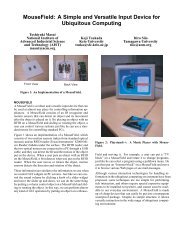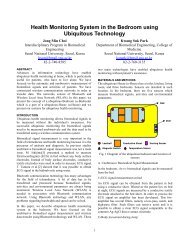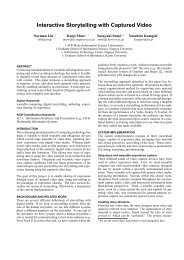frameworks with respect to different aspects of concernhave been proposed. Cawthon, N. et al. [2] put forward aconceptual model to evaluate the aesthetic effect withinuser experience, and suggested that it was imperative todevelop a user-centered evaluation method that concernsmore than task efficiency metrics. Mahlke, S. et al. [4]proposed a research approach to the experimental study ofemotional experience and its connections to othercomponents of user experience, and put forward a model ofuser experience that integrates interaction characteristics,instrumental and non-instrumental quality perceptions,emotional user reactions and overall judgments of systemquality. Mourouzis, A. et al. [7] presented a qualitativeevaluation framework for specifying and measuring the useroriented interactive products and especially emphasized thedeterminant influence that accessibility performs when itcomes to the evaluation of user experience.All the above mentioned evaluation models for userexperience have several common grounds. First, all thesemodels concentrate on the evaluation of individual userexperience, and none of them deals with the evaluation ofgroup user experience. Secondly, most of these modelsemphasize the importance of the emotion factor, which issomething quite difficult to evaluate, while seldom havethey analyzed or evaluated user experience from theperspective of knowledge acquisition. Lastly, all thesemodels, except for the one proposed in [5], evaluate userexperience in a qualitative rather than a quantitative manner.The main difference between our work and the existingones is that we focus on the quantitative evaluation of groupuser experience from the perspective of knowledgeacquisition.DEFINITION AND ANALYSIS OF GROUP USEREXPERIENCEUser ExperienceTo build an evaluation model of group user experience, wemust understand the meaning of user experience. Variousdefinitions of user experience have been proposed.Cawthon, N. et al. [2] argue that user experience is “asubject commonly tied to interactive applications –typically software and web interfaces which holisticallydescribes the relationship a user has when using anapplication and the resulting product of this interaction”;Goto, K. [3] defines user experience as “the overallperception and comprehensive interaction an individual haswith an company, service or product”; and in Wikipedia[11], which is a free web-based on-line knowledge base,user experience is defined as “a term used to describe theoverall experience and satisfaction a user has when using aproduct or system”.From these definitions, we can safely draw aconclusion that user experience is something people feelbefore, during and after they have interacted with a system,service or product, in that, user experience is to some extentan emotional state. However, considering that emotion issomething really difficult to evaluate, in this paper wewould not concentrate on the emotional aspects when itcomes to user experience, but rather on user’s knowledgeexperience, where knowledge comprises the user’s cultural,historical and aesthetic acquisitions. For instance, whenvisiting a museum, the user experience mainly refers to theexperience aroused by the cultural and historical knowledgeacquired from the exhibits.Classification of User GroupsGenerally speaking, the relationship and familiarity amongmembers in different kinds of user groups vary from one toanother, leading to distinct individual behaviors in differentgroups. For instance, when visiting museums with a touristgroup, people tend to concentrate on the nature and thecontent of the exhibits, and there is hardly anyintercommunication as their attention is more focusedtowards what they see than towards their own social group.On the contrary, people touring with their family wouldtypically focus on their family members, trying to make theexhibition understandable and the visit enjoyable. On theother hand, when touring with friends, people are usuallyconcerned not only with what they see but also theintercommunion with their friends.Considering the diversity of user groups, it is useful tocategorize them in a systematic manner that makes it easierto distinguish and comprehend and also facilitate theevaluation of group user experience. We, therefore,introduce a classification scheme for user groups based onthe criteria of whether the positions of group members areequal and how familiar group members are with each other.Thereby, user groups can be divided into homogeneousgroups and heterogeneous groups according to therelationships among group members. Homogeneous groupsrefer to the groups in which positions of members are equaland members have the same privileges. Friends and touristgroup belong to this kind of groups. On the other hand,heterogeneous groups are defined as groups in whichmembers are unequal and have different privileges. Familyis of this kind of groups. Similarly, according to the extentof group members’ familiarity to each other, user groupscan be divided, in another dimension, into tightly coupledgroups and loosely coupled groups. Tightly coupled groupsare those whose members are close to each other and theintercommunication plays an important role. Family andfriends fall into this type. On the contrary, loosely coupledgroups refer to the groups in which members are relativelyestranged and the intercommunication is not so frequentand important. Tourist group is of this kind.As a consequence, we introduce four distinctcategories of user groups — the tightly coupledhomogeneous groups, the loosely coupled homogeneousgroups, the tightly coupled heterogeneous groups and theloosely coupled heterogeneous groups.Group User ExperienceUsers can be either individuals or members of groups;similarly, user experience can be categorized into eitherexperience of an individual user or the overall experience of40
a group of users. We, therefore, introduce the concept ofgroup user experience. In contrast to individual userexperience that describes an individual’s experience ofknowledge, culture, history or aesthetics, group userexperience describes the overall experience acquired by auser group, including not only each member’s directindividual experience but also the indirect experienceacquired through intercommunication among groupmembers. For instance, suppose that you are visiting amuseum together with several friends, you can acquireexperience from what you see, which is direct experience,and at the same time you can also acquire experience fromwhat your friends see through intercommunication withthem which is indirect experience. Group user experience isthe composite of both each group member’s directexperience and indirect experience.Apparently, different types of user groups would resultin different kinds of evaluation models of group userexperience. Consider tightly coupled heterogeneous usergroups, such as a family, children are superior to theirparents when they visit a museum because, as we havementioned above, parents do not care what they seethemselves so much as what their children see. From thispoint of view, the experience of children is just theexperience of their parents. Therefore, the evaluation modelof this kind of user groups should give a heavier weight tothe members with higher priority than the others and shouldtake the intercommunication among members into account.On the other hand, the evaluation model of loosely coupledhomogeneous groups should give the same weight to eachmember and should not calculate the intercommunication.In the following section, we will introduce a generalquantitative evaluation model of group user experiencewhich is suitable for different kinds of user groups.QUANTITATIVE EVALUATION MODEL OF GROUPUSER EXPERIENCEAt the beginning of this section, we list the notations to beused in the evaluation model as follows. G : a user group. u : a group member. i : a item. R( ui , ) : the rating for item i given by groupmember u . Impact( u, i ): the revised rating for item i given bygroup member u . Au ( ) : the items that have been visited by groupmember u . AG ( ): the items that have been visited by any memberof group G . Gi (): the members who have visited item i . Eui ( , ): the experience of user u acquired from itemi . Eu ( ): the direct experience of user u . Eu ( ) : the indirect experience of user u . EG ( ): the overall experience of user group G .Quantitative Evaluation of Individual User ExperienceWe first introduce the quantitative evaluation model ofindividual user experience. For quantitative evaluation,quantitative parameters must be selected in advance.Currently, the most widely used evaluation parameter isuser rating, which thereby is also adopted as one of theparameters in this paper. One hundred scales, from 1 (thelowest experience) to 10 (the highest experience), aredesigned for the value range of user ratings. To improveaccuracy, user ratings are revised via the following twosteps.Normalization. It is possible that an individual’s rating maybe too low or too high. This can be revised throughnormalization. We apply normalization to user ratings asfollow. Rvi (,)vG()iGroupAverRating() i | Gi ( )|, i A( u), (1) R( ui , )iA( u)IndividualAverRating( u)| Au ( )|, (2)R( u, i) GroupAverRating( i)Normalized( R( u, i)) , i A( u).IndividualAverRating( u)(3)In the above equations, GroupAverRating()i is theaverage rating for item i given by members of groupGi () and IndividualAverRating( u ) is the average ratingof user u .Making the rating quadratic. An investigation by Masthoff,J. showed that the relationship between user experience andthe ratings they give are not linear, that is, for example, thedifference between the rating 6 and rating 7 is not the sameas the difference between the rating 9 and 10. Quadratic is abetter measurement than linear [6]. We use the followingequation to apply quadratic.Quadratic( R(,)) u i R(,) u i R( u,)i . (4)Combining equations (3) and (4), we have the reviseduser rating Impact( u, i ) asImpact( u, i) Quadratic( Normalized( R( u, i))). (5)After revision through the above mentioned two steps,Impact( u, i ) is a more accurate evaluation parameter thanthe original user rating. However, even though two usersgive the same ratings to a certain item, it is still very likelythat their experiences on this item are different. This may becaused by several distinct factors, an important one ofwhich is the user attention duration. So, besides user ratings,we import the user attention duration as another evaluationfactor. In this paper, we introduce user attention duration41
- Page 3 and 4: We would also like to extend a spec
- Page 5 and 6: ∙ USE‐03 Clinical Proof‐of‐
- Page 7 and 8: Ubiquitous Sustainability: Citizen
- Page 9 and 10: Devices that Alter Perception (DAP
- Page 11 and 12: incorporated into the body; if it d
- Page 13 and 14: vise. Beginning improvisers typical
- Page 15 and 16: Location-based Social Networking Sy
- Page 17 and 18: PrivacyWith any social networking a
- Page 19 and 20: BOXED EGO INSTALLATIONA pair of cam
- Page 21 and 22: the natural egocentric visuospatial
- Page 23 and 24: HUMAN SENSES AND ABSTRACT DANGERSOu
- Page 25 and 26: Gesture recognition as ubiquitous i
- Page 27 and 28: een developed to overcome this. For
- Page 29 and 30: 16. Myvu Corporation. Myvu Crystal.
- Page 31 and 32: especially in the fields of Ambient
- Page 33 and 34: 14. G. Riva (Editor), F. Vatalaro (
- Page 35 and 36: system, reflex arcs, and even muscl
- Page 37 and 38: 5. R. Cytowic. Synesthesia: Phenome
- Page 39 and 40: RELATED WORKLet us consider the loc
- Page 41 and 42: (a) Actual traces.(a) Actual traces
- Page 43 and 44: Figure 2. Schematic picture of the
- Page 45 and 46: notion of partial/total immersion w
- Page 47: A Quantitative Evaluation Model of
- Page 51 and 52: During the above discussion, user g
- Page 53 and 54: Usability Study of Indoor Mobile Na
- Page 56 and 57: 11%3%0%0%30%19%5%3%0%11%56%Notifyed
- Page 58 and 59: CONCLUSIONFor this study, we have d
- Page 60 and 61: are suited to provide sufficient cl
- Page 62 and 63: attention to your blood pressure re
- Page 64 and 65: invested in final development and c
- Page 66 and 67: 4. rhythms - the highly predictable
- Page 68 and 69: technologies, especially their coll
- Page 70 and 71: Situvis: Visualising Multivariate C
- Page 72 and 73: all. A user selecting a range withi
- Page 74 and 75: constraints to include traces that
- Page 76 and 77: Simulation Framework in Second Life
- Page 78 and 79: VirtualEmitterEstimatedPositionVirt
- Page 80 and 81: odies) then our approach would faci
- Page 82 and 83: Design and Integration Principles f
- Page 84 and 85: asis for interaction, it focuses on
- Page 86 and 87: to support POST and GET messages as
- Page 88 and 89: senor node’s functionalities in a
- Page 90 and 91: service model and provide paradigms
- Page 92 and 93: Virtualization of resources will fa
- Page 94 and 95: Figure 3. Heating and lighting cont
- Page 96 and 97: sat down at the same time” can be
- Page 98 and 99:
10!; !< !=!"#$%&’"()%* +$(%,-’#
- Page 100 and 101:
posite event operators such as conj
- Page 102 and 103:
objects? If these particles were sm
- Page 104 and 105:
Over-the-air-programmingOTAP (Over-
- Page 106 and 107:
Randomised Collaborative Transmissi
- Page 108 and 109:
Figure 2. Illustration of periodic
- Page 110 and 111:
Figure 3. Illustration of the recei
- Page 112 and 113:
Experimental Wired Co-operation Arc
- Page 114 and 115:
The structure of network is matrix
- Page 116 and 117:
Altera Quartus II v7.2SP3 FPGA soft
- Page 118 and 119:
Using smart objects as the building
- Page 120 and 121:
To the ambient ecology concepts des
- Page 122 and 123:
event. A more complicated approach
- Page 124 and 125:
Multi-Tracker: Interactive Smart Ob
- Page 126 and 127:
interfacing with whole space, but c
- Page 128 and 129:
operate interactions by many partic
- Page 130 and 131:
An Augmented Book and Its Applicati
- Page 132 and 133:
its withy material. So, the movemen
- Page 134 and 135:
Table 1. The Performance of Page Fl
- Page 136 and 137:
Ambient Information SystemsWilliam
- Page 138 and 139:
We, too, believe there is a certain
- Page 140 and 141:
management system and forwarded to
- Page 142 and 143:
CONCLUSIONWe have presented the des
- Page 144 and 145:
Ambient interface design for a Mobi
- Page 146 and 147:
as ‘sensitive’ and filtered awa
- Page 148 and 149:
Ambient Life: Interrupted Permanent
- Page 150 and 151:
The log files revealed the actual r
- Page 152 and 153:
Stay-in-touch: a system for ambient
- Page 154 and 155:
Figure 1. The Stay-in-touch display
- Page 156 and 157:
User Generated Ambient PresenceGerm
- Page 158 and 159:
Figure 3: Cross-platform system tra
- Page 160 and 161:
The Invisible Display - Design Stra
- Page 162 and 163:
On a more general level Mimikry cre
- Page 164 and 165:
Rand in fact few examples of public
- Page 166 and 167:
Ambient Displays in Academic Settin
- Page 168 and 169:
usefulProfiles 22 (37%)Time and dat
- Page 170 and 171:
UTILIZE THE POTENTIAL TO FULLEST: D
- Page 172 and 173:
A notification system for a landmin
- Page 174 and 175:
As for the investigation phase, whe
- Page 176 and 177:
Ubiquitous Sustainability: Citizen
- Page 178 and 179:
Live Sustainability: A System for P
- Page 180 and 181:
(a) (b) (c)Figure 3. Screenshot for
- Page 182 and 183:
Motivating Sustainable BehaviorIan
- Page 184 and 185:
dialog with policy makers and servi
- Page 186 and 187:
5. Fogg, B. J. (2002). “Persuasiv
- Page 188 and 189:
on mode of transportation such as t
- Page 190 and 191:
In order to be useful, PET requires
- Page 192 and 193:
provides a relevant description and
- Page 194 and 195:
Star, L. S., The Ethnography of Inf
- Page 196 and 197:
door environment, the accuracy of G
- Page 198 and 199:
Figure 5. Variations of “Parasiti
- Page 200 and 201:
can view where it has been, who ans
- Page 202 and 203:
Nevermind UbiquityJeff BurkeCenter
- Page 204 and 205:
innovating within existing capacity
- Page 206 and 207:
Since the Brundlandt report a serie
- Page 208 and 209:
our current research in mobile gami
- Page 210 and 211:
conceive only of human-computer int
- Page 212 and 213:
human behaviour will encounter. The
- Page 214 and 215:
mental models of the world are test
- Page 216 and 217:
alternative, the place that could h
- Page 218 and 219:
elow the mode button indicate the c
- Page 220 and 221:
212
- Page 222 and 223:
digital collection of features to a
- Page 224 and 225:
immediately followed by a subset of
- Page 226 and 227:
forecast the future accesses to tho
- Page 228 and 229:
Enhanced and Continuously Connected
- Page 230 and 231:
than two application windows execut
- Page 232 and 233:
Secure and Dynamic Coordination ofH
- Page 234 and 235:
AudioProducer/ConsumerVideoConsumer
- Page 236 and 237:
228
- Page 238 and 239:
MotivationsMotivations occurred on
- Page 240:
Kray Christian ··········






